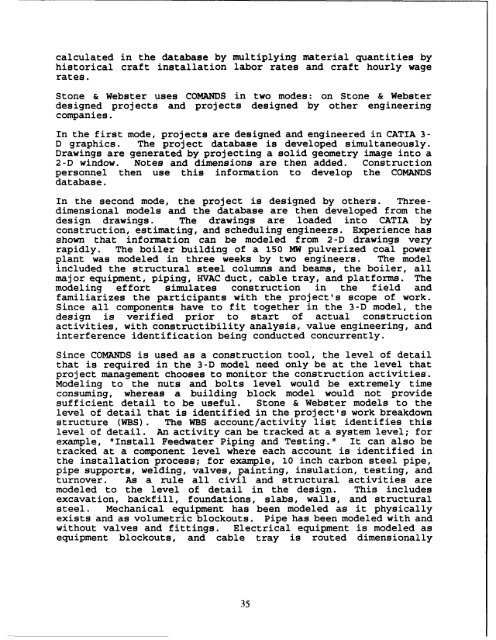Challenges and Opportunities for Innovation in the Public Works ...
Challenges and Opportunities for Innovation in the Public Works ...
Challenges and Opportunities for Innovation in the Public Works ...
You also want an ePaper? Increase the reach of your titles
YUMPU automatically turns print PDFs into web optimized ePapers that Google loves.
calculated <strong>in</strong> <strong>the</strong> database by multiply<strong>in</strong>g material quantities by<br />
historical craft <strong>in</strong>stallation labor rates <strong>and</strong> craft hourly wage<br />
rates.<br />
Stone & Webster uses COMANDS <strong>in</strong> two modes: on Stone & Webster<br />
designed projects <strong>and</strong> projects designed by o<strong>the</strong>r eng<strong>in</strong>eer<strong>in</strong>g<br />
companies.<br />
In <strong>the</strong> first mode, projects are designed <strong>and</strong> eng<strong>in</strong>eered <strong>in</strong> CATIA 3-<br />
D graphics. The project database is developed simultaneously.<br />
Draw<strong>in</strong>gs are generated by project<strong>in</strong>g a solid geometry image <strong>in</strong>to a<br />
2-D w<strong>in</strong>dow. Notes <strong>and</strong> dimensions are <strong>the</strong>n added. Construction<br />
personnel <strong>the</strong>n use this <strong>in</strong><strong>for</strong>mation to develop <strong>the</strong> COMANDS<br />
database.<br />
In <strong>the</strong> second mode, <strong>the</strong> project is designed by o<strong>the</strong>rs. Threedimensional<br />
models <strong>and</strong> <strong>the</strong> database are <strong>the</strong>n developed from <strong>the</strong><br />
design draw<strong>in</strong>gs. The draw<strong>in</strong>gs are loaded <strong>in</strong>to CATIA by<br />
construction, estimat<strong>in</strong>g, <strong>and</strong> schedul<strong>in</strong>g eng<strong>in</strong>eers. Experience has<br />
shown that <strong>in</strong><strong>for</strong>mation can be modeled from 2-D draw<strong>in</strong>gs very<br />
rapidly. The boiler build<strong>in</strong>g of a 150 MW pulverized coal power<br />
plant was modeled <strong>in</strong> three weeks by two eng<strong>in</strong>eers. The model<br />
<strong>in</strong>cluded <strong>the</strong> structural steel columns <strong>and</strong> beams, <strong>the</strong> boiler, all<br />
major equipment, pip<strong>in</strong>g, HVAC duct, cable tray, <strong>and</strong> plat<strong>for</strong>ms. The<br />
model<strong>in</strong>g ef<strong>for</strong>t simulates construction <strong>in</strong> <strong>the</strong> field <strong>and</strong><br />
familiarizes <strong>the</strong> participants with <strong>the</strong> project's scope of work.<br />
S<strong>in</strong>ce all components have to fit toge<strong>the</strong>r <strong>in</strong> <strong>the</strong> 3-D model, <strong>the</strong><br />
design is verified prior to start of actual construction<br />
activities, with constructibility analysis, value eng<strong>in</strong>eer<strong>in</strong>g, <strong>and</strong><br />
<strong>in</strong>terference identification be<strong>in</strong>g conducted concurrently.<br />
S<strong>in</strong>ce COMANDS is used as a construction tool, <strong>the</strong> level of detail<br />
that is required <strong>in</strong> <strong>the</strong> 3-D model need only be at <strong>the</strong> level that<br />
project management chooses to monitor <strong>the</strong> construction activities.<br />
Model<strong>in</strong>g to <strong>the</strong> nuts <strong>and</strong> bolts level would be extremely time<br />
consum<strong>in</strong>g, whereas a build<strong>in</strong>g block model would not provide<br />
sufficient detail to be useful. Stone & Webster models to <strong>the</strong><br />
level of detail that is identified <strong>in</strong> <strong>the</strong> project's work breakdown<br />
structure (WBS). The WBS account/activity list identifies this<br />
level of detail. An activity can be tracked at a system level; <strong>for</strong><br />
example, "Install Feedwater Pip<strong>in</strong>g <strong>and</strong> Test<strong>in</strong>g." It can also be<br />
tracked at a component level where each account is identified <strong>in</strong><br />
<strong>the</strong> <strong>in</strong>stallation process; <strong>for</strong> example, 10 <strong>in</strong>ch carbon steel pipe,<br />
pipe supports, weld<strong>in</strong>g, valves, pa<strong>in</strong>t<strong>in</strong>g, <strong>in</strong>sulation, test<strong>in</strong>g, <strong>and</strong><br />
turnover. As a rule all civil <strong>and</strong> structural activities are<br />
modeled to <strong>the</strong> level of detail <strong>in</strong> <strong>the</strong> design. This <strong>in</strong>cludes<br />
excavation, backfill, foundations, slabs, walls, <strong>and</strong> structural<br />
steel. Mechanical equipment has been modeled as it physically<br />
exists <strong>and</strong> as volumetric blockouts. Pipe has been modeled with <strong>and</strong><br />
without valves <strong>and</strong> fitt<strong>in</strong>gs. Electrical equipment is modeled as<br />
equipment blockouts, <strong>and</strong> cable tray is routed dimensionally<br />
35







